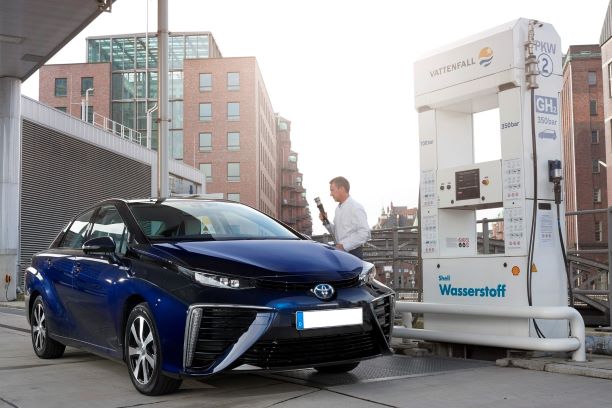Hydrogen
Hydrogen will be of great importance for climate-friendly mobility in the future. Short refueling times, long ranges, good comfort and low weight are important arguments for fuel cell vehicles (FCEV). Hydrogen cars – unlike electric vehicles – already today achieve performances comparable to those of a gasoline engine with no local emissions. The fuel cell plays an important role especially in heavy commercial vehicles and partly also in buses. The battery will not be suitable for transporting heavy loads over long distances in the foreseeable future.
Some international manufacturers are leaders in the development of fuel cell vehicles. They already offer fuel cell vehicles that are ready for series production and suitable for everyday use. The international manufacturers are also involved in setting up the necessary hydrogen filling station infrastructure.

Recommendations
To ensure that hydrogen continues to gain in importance as a fuel in Germany as well, the international manufacturers recommend that the Federal Government create optimal framework conditions. In order to achieve this, it is particularly important to ensure that the development of a nationwide network of hydrogen filling stations continues at a rapid pace. The targets set for 100 filling stations and a further 300 subsequently should be achieved. The production of renewable hydrogen in Germany should be triggered from 2021 onwards by funding generation plants with one to two billion euros. In order to ensure that significantly more fuel cell cars are put on the roads, it will be necessary to provide tailored support for the purchase and operation of these vehicles. After all, the public sector can make a considerable contribution through the targeted procurement of FCEVs.
How does a fuel cell car work?
In a fuel cell car, hydrogen is stored in specially developed tanks under the vehicle interior. To drive the car, the hydrogen is fed into the fuel cell, where it reacts with the oxygen that enters the compressor through air inlets. This chemical reaction produces the electricity that drives the electric motor. The only completely harmless emission product, water vapor, is discharged to the outside. In addition, the braking energy is stored in a high-voltage battery and used as support during overtaking manoeuvres, for example.
Emissions of hydrogen cars in comparison
Comparing the climate balance of fuel cell vehicles and battery electric vehicles, one thing becomes clear: both hydrogen and electricity are not yet produced 100 percent from renewable energies. Hydrogen is mostly produced from natural gas. With today’s German electricity mix, electricity generation also causes CO2 emissions. Even the production of fuel cell and electric cars is not climate-neutral. And yet numerous studies show that both systems already enable lower CO2 mobility today than vehicles with petrol or diesel engines.
This CO2 advantage will increase significantly in the future: The higher the proportion of electricity or hydrogen generated from renewable sources, the lower the greenhouse gas emissions. If 100 percent renewable energies are used, both fuel cell vehicles and battery electric cars will be far superior to conventional combustion engines in terms of climate balance.

Filling station network
Currently, drivers have to plan their routes for long distances in order to be able to reach the next hydrogen filling station in time. But by 2023 there should be around 400 stations in Germany where hydrogen can be refuelled.
H2 Mobility, a company supported by the petroleum industry and the automotive industry, is responsible for the nationwide development of a hydrogen infrastructure in Germany. Three international manufacturers accompany H2 Mobility as associated partners. H2 Mobility also receives funding from the German government’s National Innovation Programme for Hydrogen and Fuel Cell Technology (NIP) and from the European Commission in the Hydrogen Mobility Europe project.

